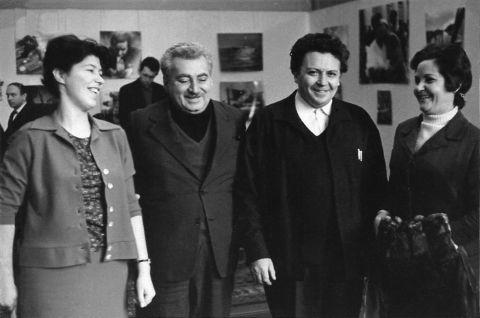Jorge Amado And Anatoly Gitberg
|
A. Gitberg’s wife Emilya Glazkova, the world-famous Brazilian writer Jorge Amado, the artist Anatoly Gitberg, and J. Amado’s wife Zélia Gattai Amado de Faria. The Brazilian embassy, Moscow, 1967. |
Jorge Amado And Anatoly GitbergFamous Brazilian writer Jorge Amado had visited Moscow In December of 1967 with his wife. While staying at the Brazilian embassy he found the calendar published by the Russian News Agency and asked who illustrated it? He thought that the drawings for the calendar were made by a naive artist. Anatoly Gitberg was commissioned by the News Agency to make illustrations for the 1967 calendar to promote Postal services. 12 sheets and the cover tell the story of the envelope that was mailed from the North Pole to the South Pole on its path through various countries. Postmen from Norway, England, France, Italy, USA, Ghana etc. were all dressed in national costumes while using traditional means of transportation: dogs in the North, lamas in Peru, camels the desert of Arabia. Amado had decided he wants to meet an artist. He had visited artist’s workshop on Sretensky Boulevard shortly after. Anatoly Gitberg showed his works to the writer and gave him a copy of the calendar and two gouache paintings from the cycle "Old towns of Russia” as a present. He also explained that he intentionally stylized drawings for the calendar in a form of the naive art. Jorge Amado wrote several friendly words addressing Gitberg’s art in the visitor’s book. This visit was followed by official invitation of the artist and his wife to The Brazilian embassy where this photograph was taken.
Jorge Leal Amado de Faria ([ˈʒɔʁʒi lɛˈaw ɐˈmadu dʒi fɐˈɾi.ɐ], 10 August 1912 – 6 August 2001) was a Brazilian writer of the modernist school. He remains the best known of modern Brazilian writers, with his work having been translated into some 49 languages and popularized in film, notably Dona Flor and Her Two Husbands in 1976. His work reflects the image of a Mestiço Brazil and is marked by religious syncretism. He depicted a cheerful and optimistic country that was beset, at the same time, with deep social and economic differences. He occupied the 23rd chair of the Brazilian Academy of Letters from 1961 until his death in 2001. |
|
The art of Anatoly Gitberg is full of vigor and beauty and conveys features characteristic of the Russian landscape and the Russian people. His gift is at its peak. (Jorge Amado, 1967) |


